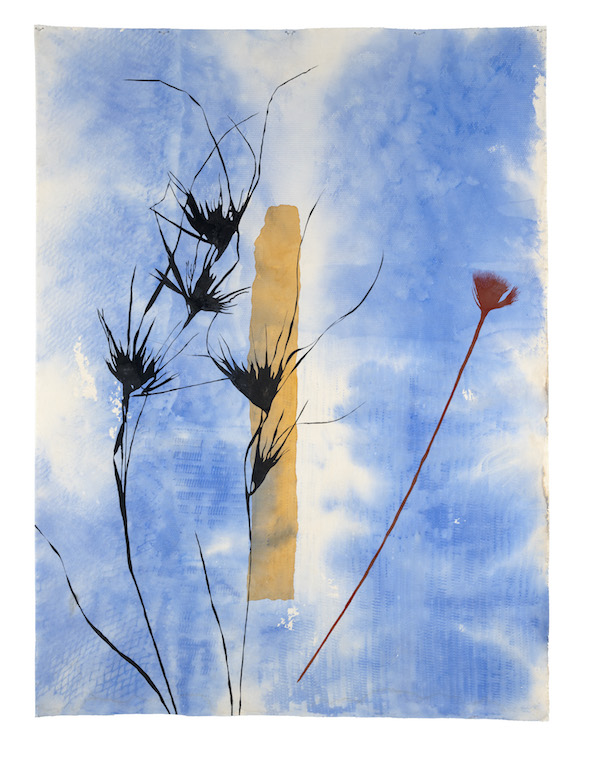
Culture Critic Orla Taylor-Davies reviews Australian Artist Judy Watson’s current exhibition at the Ikon Gallery
The complex nature of institutional discrimination against Aboriginal communities’ manifests in various ways in Judy Watson’s work. The seeping colours and overlapping patterns of her paintings immediately evoke a dreamlike experience of viewing, as one languidly contemplates these imprecise forms. But this is disrupted when one considers the spiky, dark shapes often in the centre of the canvas. They seem to focus the work and allude to a more precise and urgent meaning.
“The seeping colours and overlapping patterns of her paintings immediately evoke a dreamlike experience of viewing
On closer inspection, certain patterns look familiar and it is clear something troubling lurks beneath these works. Indeed, in ‘standing stone’, ‘kangaroo grass’ and ‘bush string’, the phrases ‘water as weapon’ and ‘poison chalice’ refer to the use of water by colonial forces for the dispossession and massacre of Aboriginal people. The dark shape of the bush string against the bleeding blue dyes suggests that it is floating on a body of water, referring to the deep connection between Aboriginal cultures and their land, often threatened by corporate industrialisation.
“The dark shape of the bush string against the bleeding blue dyes suggests that it is floating on a body of water, referring to the deep connection between Aboriginal cultures and their land
Watson states that art as a vehicle for social change has the potential to be ‘soft, hard, in your face confrontational, or subtle or discrete’. She aligns her practise with the latter, describing the messages that imbue the ‘seductive beautiful exterior’ of her work as deadly poison darts ‘that insinuate itself into the consciousness of the viewer’. Details that at first seem merely decorative are representative of the personal and cultural experiences of Aboriginal communities. Stitches contributed to some of Watson’s works by family members and colleagues, the depiction of Kangaroo Grass found in endangered grasslands, and Watson’s use of traditional techniques all reaffirm ownership and establish resistance in the face of cultural repression. Repetitive, circular forms reference the buttons worn by mounted police recruited from a British military regiment to suppress and massacre Aboriginal people.

Genocide is directly addressed in Watson’s installation, ‘40 pairs of blackfellows’ ears, lawn hill station’. Forty beeswax sculptures of ears pinned to the wall tell the story of the brutality inflicted upon Aboriginal people in Waanyi country by Jack Watson (no relation to the artist), who proudly displayed ears torn from murdered Aboriginals on a slab hut homestead. The slender, sharp objects, named Resistance Pins, placed beside this bleak installation, ensure that Aboriginal communities are not represented in this section of the exhibition as passive victims; these delicate objects were used by women to defend against potential attackers.
“Forty beeswax sculptures of ears pinned to the wall tell the story of the brutality inflicted upon Aboriginal people in Waanyi country
The overlapping of aesthetically soothing forms and references to troubling events within Watson’s paintings is repeated in her video work. In the video entitled ‘invasion’, filmed during Watson’s travels to British sites of pre-historical significance such as the Stonehenge and Avebury, locations are overlaid with human bones and hair stolen from Aboriginal people and currently residing in British museum collections. She explains the ‘images of standing stone forms-shadowy or very ghostly presences- and the floating of Aboriginal cultural material across the top’ as a ‘layering of experiences and a layering of understanding of what is culture’. The super-imposition of artefacts of trauma over quintessentially British landscapes reminds the viewer of the history and legacy of cultural invasion, and the entwinement of these histories despite geographical distance.

“Watson’s most comprehensive international exhibition to date encouraged viewers to re-evaluate how to look at art
Overall, Watson’s most comprehensive international exhibition to date encouraged viewers to re-evaluate how to look at art, to uproot the hints and glimmers of what curatorial advisor Hetti Perkins called Australia’s ‘secret war’, from the enticing blots of colour and pattern that make up Watson’s work. I felt privileged to have learnt about a history that does not receive mainstream coverage in Britain, and Watson’s often subtle, sometimes blunt, manner of addressing the experiences of Aboriginal communities throughout history captured the nature of the oppression she represented; multi-faceted, its visibility sometimes heightened, often hidden, but always ingrained, underlying and met with resistance.

Comments